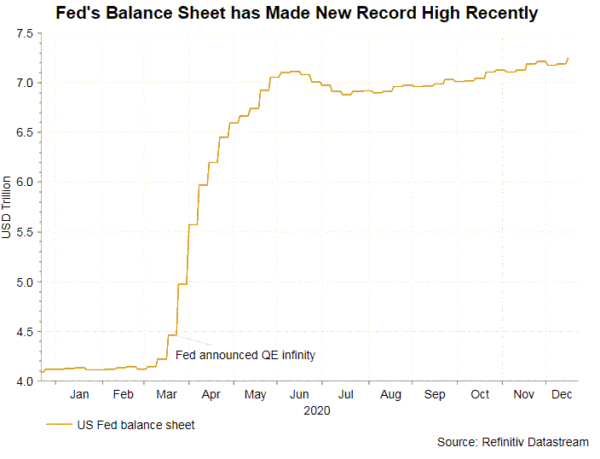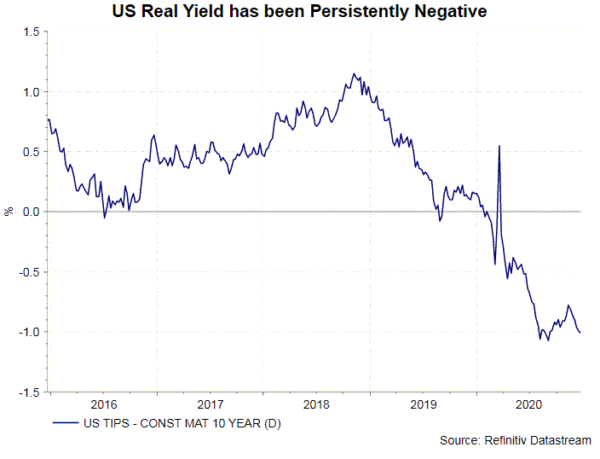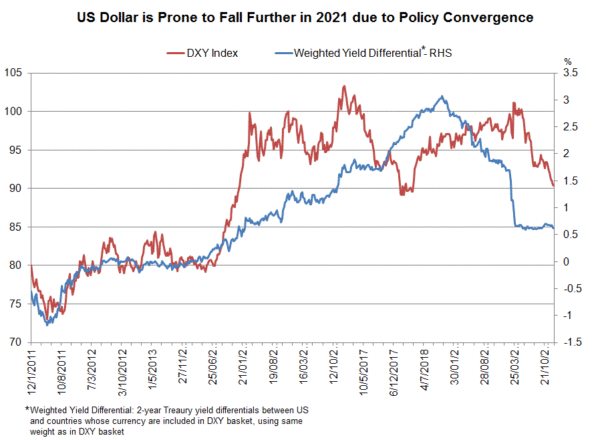The DXY index will likely record a -6% fall in 2020, the first decline in 3 years. Although US economic recovery should lend support to the dollar, exceptionally accommodative monetary policy, widening deficit (exacerbated by the new round of fiscal stimulus) and reduced demand for safe-haven asset should keep US dollar weak in the coming year.
Ultra Monetary Accommodation and Policy Convergence
The once-in-a-century coronavirus pandemic, originated in Wuhan, China, spread rapidly all over the world in 1Q20. The sudden and tremendous attack of the new virus has led to lockdown and related restrictive measures by countries (essentially every country) affected. Global central banks have also announced unprecedented monetary stimulus measures. After announcing to buy unlimited amount of assets to boost the economy in March, the Fed later set the size to US$120B of Treasury and mortgage-backed securities. In September, the central bank changed to average inflation targeting, pledging to leave the Fed funds rate at the effective lower bound of 0-0.25% for sometime even after inflation has surpassed 2%. Although the Fed has been reluctant to adopting negative policy rate, the move to average inflation targeting has effectively sent the real interest rate to negative. It will likely stay negative for the years to come.

Not only would a dovish Fed keep the dollar on defensive, policy convergence has also eliminated the advantage of holding the greenback. In 2018 and 2019, a key driver of USD’s strength against major currencies had been the relatively higher US yields. For instance, the US-EU 2-year Treasury yield differential was 3.12% and 2.64% in 2018 and 2019 respectively. It was narrowed significantly to 1.1% year-to- date and even to 0.86% from March to December. We expect the trend to continue in the coming year. Although ECB has pledged to keep its policies expansionary by enlarging and extending its QE programs over the past meetings, the Fed is likely to react proactively to keep the dollar low. Given, the strong correlation between currency pairs and yield differential, elimination US interest rate advantage suggest the dollar, represented by DXY index of which over 50% of the basket is composed of the euro, would stay weak.
Components of DXY Index
| Currency | Weight (%) |
| EUR | 57.6 |
| JPY | 13.6 |
| GBP | 11.9 |
| CAD | 9.1 |
| SEK | 4.2 |
| CHF | 3.6 |
Fiscal Stimulus Exacerbating Twin Deficit
The US congress has struck a US$900B fiscal deal before Christmas. Despite Trump’s threat to veto the bill without raising the“ridiculously low” US$600 stimulus checks to US$2,000 among other changes, we believe the new round of stimulus will eventually be approved. This bill, together with the US$2.2 trillion one implemented earlier, should significantly increase the US budget and current account deficits in the US. This is likely to weigh on the dollar in the long term.
Lower Demand for Safe Haven as Global Economy Out of Woods
Vaccine news in 4Q20 has lifted market optimism and pressured safe-haven assets, including US dollar. Given the base case that the worst is behind us and green shoots are evolving in the global economy, the greenback’s demand as safe-haven should further reduced in the coming year. Recent discovery of more transmissible virus variants might pose risk to the above view. Whether efficacy’s efficacy will be hampered is yet to be known, though.
Following the ebb and flow in 2020, Fed’s commitment to monetary easing, rising deficit as a result of fiscal stimulus and lower demand for safe haven are expected to lead to further weakness in US dollar in the coming year. Major risks to our forecast include faster-than- expected monetary tightening by the Fed, slower-than-expected economic recovery/ another fall into global recession due to resurgence of the pandemic.



 RULE-BASED Pocket Option Strategy That Actually Works | Live Trading
RULE-BASED Pocket Option Strategy That Actually Works | Live Trading